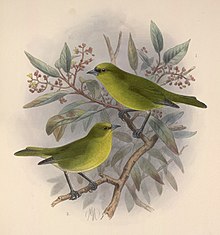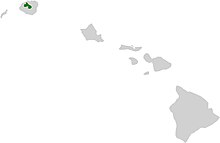ʻAkekeʻe
| ʻAkekeʻe | |
|---|---|

| |
| Male above, female below | |
| Scientific classification | |
| Domain: | Eukaryota |
| Kingdom: | Animalia |
| Phylum: | Chordata |
| Class: | Aves |
| Order: | Passeriformes |
| Family: | Fringillidae |
| Subfamily: | Carduelinae |
| Genus: | Loxops |
| Species: | L. caeruleirostris
|
| Binomial name | |
| Loxops caeruleirostris (Wilson, SB, 1890)
| |

| |
The ʻakekeʻe (Loxops caeruleirostris) or Kaua'i 'akepa is a
Description and behavior
The ʻakekeʻe is a greenish-yellow bird with a black mask around the eye (especially prominent in the male) and a bluish bill, unlike the
Habitat
The ʻakekeʻe is currently found only in the
Threats

The ʻakekeʻe is threatened by the introduction of plants like the banana pōka (
The conservation status for this species was updated to
References
- ^ . Retrieved 12 November 2021.
- ^ "Forest Birds: ʻAkekeʻe or Kauaʻi ʻĀkepa" (PDF). State of Hawaiʻi. 2005-10-01.
- ^ "BirdLife International (2009) Species factsheet: Loxops caeruleirostris". Retrieved 2010-01-30.
- ^ Kauai’s native forest birds are headed toward extinction by Sarah Zielinski, published by "Science News" on September 13, 2016
- ^ a b Paxton, Eben H.; Laut, Megan; Enomoto, Stanton; Bogardus, Michelle (2022-04-14). Hawaiian forest bird conservation strategies for minimizing the risk of extinction: biological and biocultural considerations (Report).

